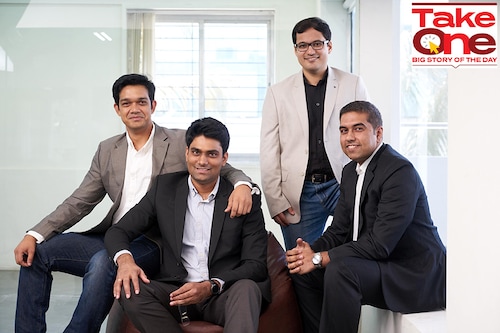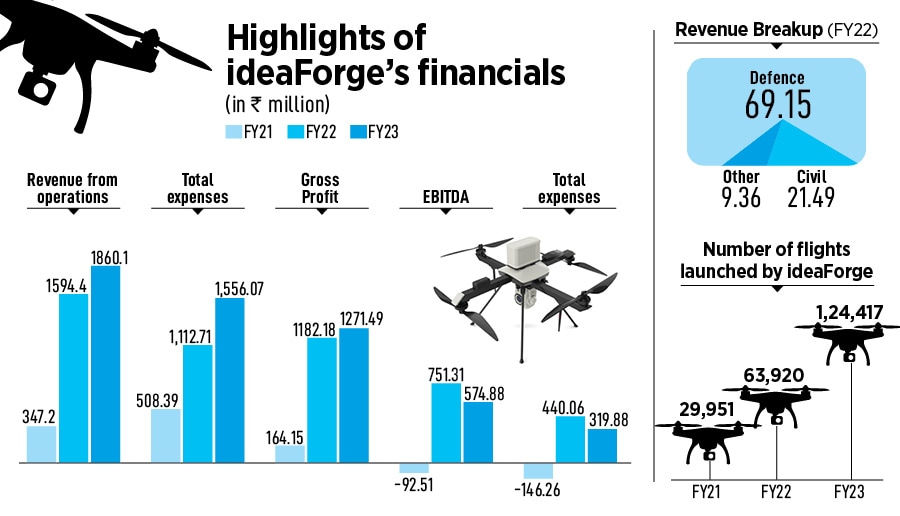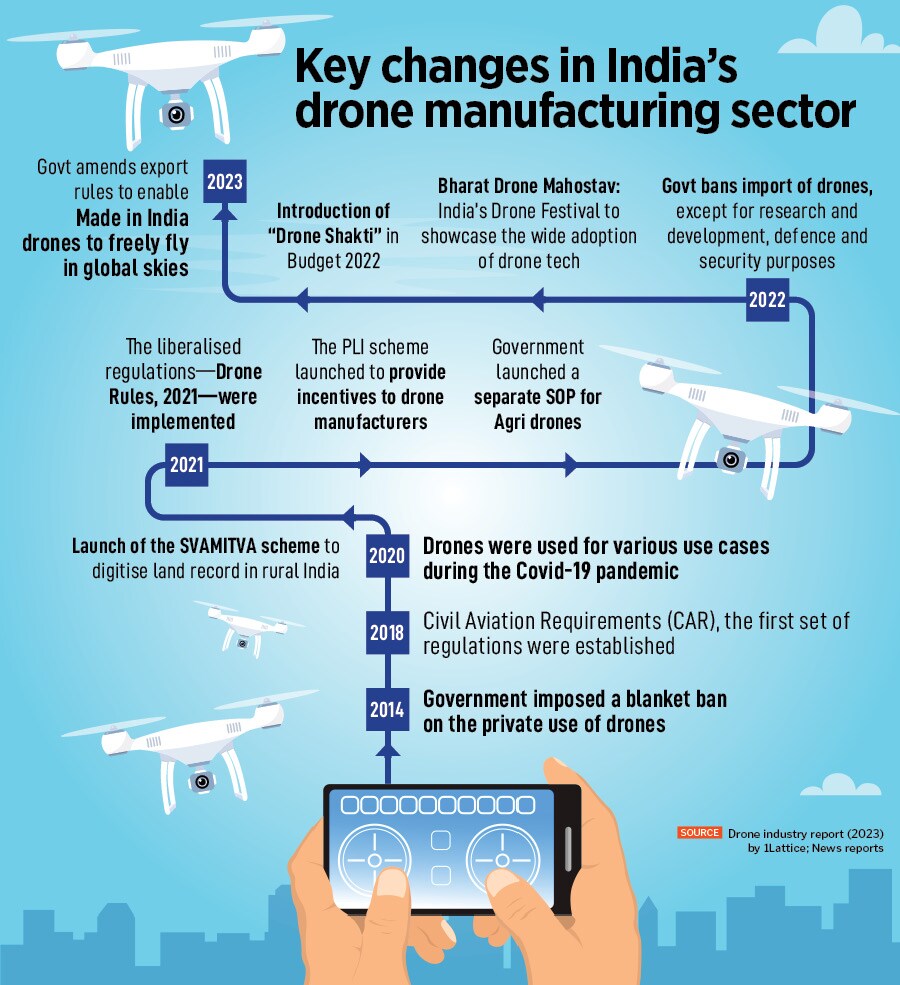Buoyed by strong IPO response, ideaForge Technology eyes scalable and profitable
The unmanned aircraft systems manufacturer saw its issue subscribed 50.3 times in three days; the company plans to use the capital to expand globally and invest in R&D


[br]
ideaForge Technology has been witnessing a strong response from investors for its Rs567-crore initial public offering (IPO) since the issue opened for subscription on June 26. The issue subscribed 50.3 times by the afternoon of June 28. The unmanned aircraft systems (UAS) manufacturer has announced to sell its shares in the price range of Rs638-672 per share.
In 2005, three IIT-Bombay students—Ankit Mehta, Rahul Singh and Ashish Bhat—started experimenting with aerial robotics. Eventually, the trio came together to incorporate ideaForge Technology in 2007. Today, it is one of the largest UAS manufacturers in the country. From FY21 to FY23, the company’s revenue jumped from Rs347.18 million to Rs1,860.07 million.
Mehta, co-founder and CEO of ideaForge, credits this growth to policy changes for the sector. The company sells drones in two main categories—Mapping and Surveying (Civil) and Security and Surveillance (Defence). A majority of its revenue was from defence: Close to 69 percent in FY23. But civil is a fast-growing category that experts reckon will help garner higher growth and revenue for the company. ideaForge’s clients include all Indian defence forces, central armed police forces, many state police forces, several government departments and large private enterprises.
The drone-maker has a 50 percent market share in the Indian UAS market. With plans to expand globally, and continue R&D, ideaForge felt the need to raise more capital. "We felt that an IPO was a better option compared to private capital," Mehta tells Forbes India during a telephonic interview. ideaForge has reserved 75 percent shares for qualified institutional buyers (QIB), 15 percent for high net-worth individuals (HNI) and 10 percent for retail investors. According to the red herring prospectus (RHP), Rs40 crore is expected to be used for product development, Rs135 crore in working capital and Rs50 crore as debt repayment.
Celesta Capital first invested in ideaForge in 2016 because they saw a clear alignment of demand for drone technology in India’s defence and enterprise markets, and a significant gap in the market to meet this need. With the defence market, particularly, ‘Make in India’ drones started getting a big push. “Given the perceived risks associated with imported drones, we recognised the urgent need for domestically manufactured ones, which could help to quickly position ideaForge as a key player in the market with the advanced capabilities they were developing," explains Gani Subramaniam, senior partner at Celesta Capital.

According to 1Lattice’s report on the drone industry, the global revenue for the drone industry is estimated at $21.1 billion in CY22. India’s drone sector was only $2.71 billion—so, the potential to grow is immense. "We have been slightly late adopters, but we are there now," says Mehta. "The government wants India to become the drone hub of the world by 2030, and to drive that potential home, induction in technology and ease in policy is growing."
The drone sector in India is at a point of inflection, believes Mehta. “Given the push from the government and the policy changes that are being implemented, we felt this was the right time for an IPO," he says. It was the pandemic that really triggered the change in mindset—where drones were being used to spray sanitisers, surveillance, delivering medicines and many more use cases. "Before the pandemic, drones were known to be a "good-to-have" technology, which was getting adopted at a very sluggish pace. But with the onset of the pandemic, it became a "must-have" technology," reckons Mehta.
In April 2020, the government launched the SVAMITVA (Survey of Villages And Mapping with Improvised Technology in Village Areas) project to enable economic progress of rural India. Drone surveying technologies would play an integral part in mapping and surveying inhabited lands in rural areas. Following this, the liberalised Drone Rules, 2021 were launched. In February 2022, the government banned the import of foreign drones to boost Indian manufacturing of drones. A few days back, it was reported that the government has liberalised the policy for the export of drones or UAVs. All these policy changes are in line with the goal to transform the country’s drone sector into a $20-billion industry by 2030. "With these changes in mind, we were assessing what we need to do to ensure that we are building the necessary systems for the use cases that will become material in the coming time," adds Mehta.

Since the issue opened, there has been a lot of chatter suggesting that ideaForge’s high valuation might not be justified. However, Sneha Poddar, AVP, Fundamental Research, Broking and Distribution, MOFSL, believes otherwise. “ideaForge is one of the largest players in the Indian drone market. The high ESOP cost in FY23, would have affected their profitability. For that reason, in terms of price–earnings ratio it is looking a little expensive—at the higher price band, the company has a P/E multiple of 87.5x (to its FY23 earning)." The average P/E ratio for the industry as stated in the RHP stands at 57.93. She adds, “If you look overall potential of the market, the valuation seems justified."
As compared to many of its peers, the company’s order book—a measure of the visibility and certainty of future revenue—is fairly low. For FY23, its order book stands at Rs1,922.72 million compared to MTAR Technologies, which is Rs11,729 million and Astra Microwave (Rs15,439.90 million). “These numbers are just a snapshot, not the complete picture. We can’t share projections, but there is clearly a lot of potential in the segments we are present in," says Mehta.
Another area of concern raised in the RHP is the significant working capital gap. The net working capital holding days have varied and historically been at 301 (FY23), 121 (FY22) and 512 (FY21). “We are hoping to bring this cycle to an average of 200 days by improving distribution network and efficiency," adds Mehta. Poddar of MOFSL believes cash flow is bound to get impacted, especially when working closely with the government.
“Cash outflows usually happen towards the end of the year, which generally affects cash flows of the company. So, whenever there is an involvement of the government, we find that the working capital cycle ends up being on the higher side," she says.
The company, like many others in the sector, is highly dependent on global vendors for the supply of components such as carbon fibre tubes, landing gear, propellors, motors and antennas required for manufacturing UAVs. Though there is a massive push from the government’s side via its production linked incentive (PLI) scheme for component manufacturing in India, in the short run, ideaForge may not be able to reduce its dependency on imports.
"The scheme has motivated the industry to invest not just behind making drones but also to look at drone component manufacturing—there are very few in the market currently," says Mehta. ideaForge has also invested in a component manufacturer of drones.
The drones that ideaForge is building have a dual use—for both defence and civil. With the additional capital from the listing, the company hopes to expand further in product development.
Says Subramaniam, “ideaForge is well-positioned for scalable and profitable growth. The company has a focus today on developing rugged drones for the enterprise and defence markets, sectors that continue to demonstrate strong demand for high-performance drone technology. The utilisation of drones in India is still at an early stage and the potential for expansion and adoption of drones across numerous industries remains largely untapped."
So far, the startup has been an India-focussed company. But with the potential of the global drone sector, “we are hoping to make the most of the relaxed export policy and expand globally as well", says Mehta. The company has already set up a subsidiary in the US to address the North American market.
First Published: Jun 29, 2023, 15:41
Subscribe Now